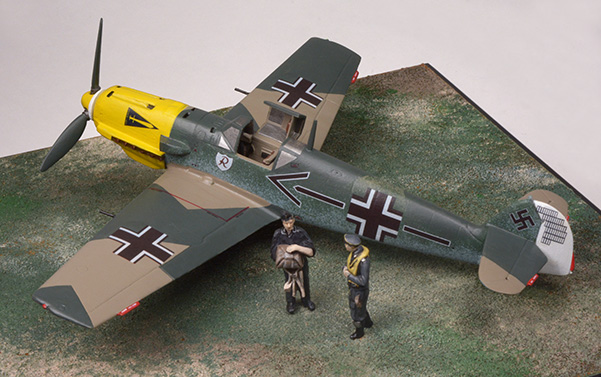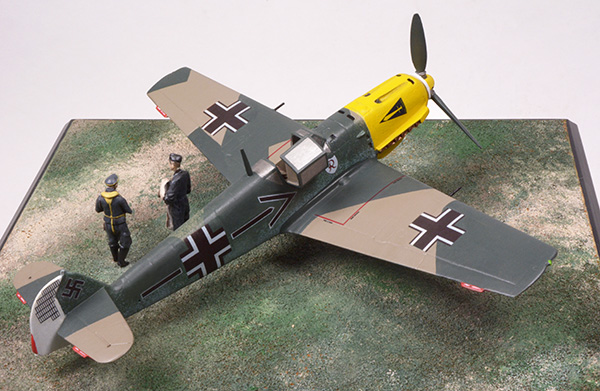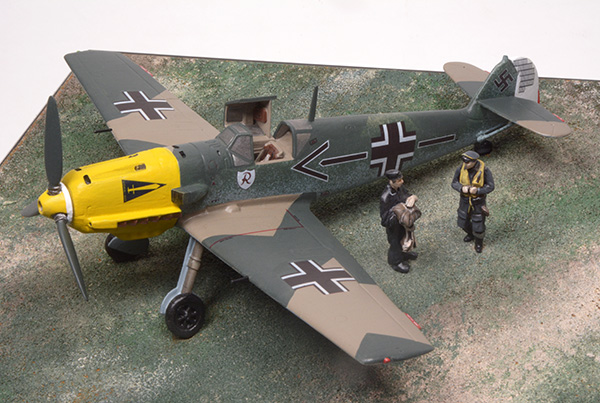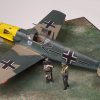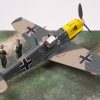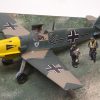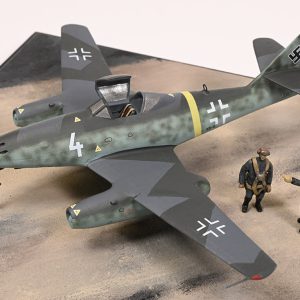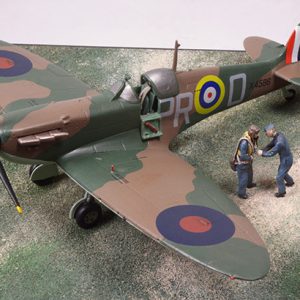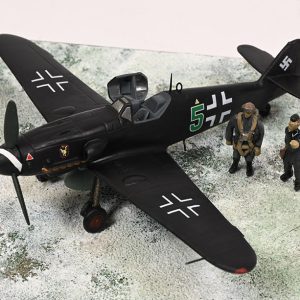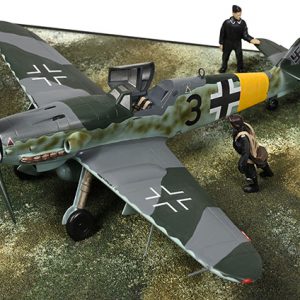Messerschmitt Bf 109E-4 ‘Chevron and Bars’ 3./JG2 ‘Richthofen’
Geschwaderkommodore Helmut Wick, Beaumont-le-Roger, November 28th 1940.
The Messerschmitt Bf 109 was designed by Willy Messerschmitt and Robert Lusser, who worked at Bayerische Flugzeugwerke during the early to mid-1930s. Whilst the Bf 109 was conceived as an interceptor, later models were developed to fulfill multiple tasks, serving as bomber escort, fighter-bomber, day-, night-, all-weather fighter, ground-attack aircraft, and as reconnaissance aircraft.
Dozens of Messerschmitt Bf 109 fighters, including the A, B, C, D, and E variants first saw active service with the Condor Legion against Soviet-supplied aircraft in mid 1937, and served as a testing ground for the new German fixed-wing fighter plane. The Bf 109 quickly replaced the Heinkel He 51 biplane fighter which suffered many losses during the first 12 months of the conflict. This proving ground taught the Luftwaffe valuable lessons for the most forthcoming and most well-known of all Bf 109 operations, ‘the Battle of Britain’. This battle of air superiority between the Royal Air Force and the Luftwaffe in the summer of 1940 was fought mainly with Bf 109E variants and created many aces, one of which was the famous pilot, Helmut Wick.
Helmut Paul Emil Wick was born on the 5th of August 1915 in Mannheim, Germany, the youngest of three children of a civil engineer, Karl Wick and Berta Wick. Owing to the demand for his father’s skills and expertise building roads and bridges, Helmut spent most of his childhood traveling throughout the German Empire. The Wick family moved to Hanover in 1919; Helmut’s mother died there in February 1922. His father then took the family to Oliva, near Danzig and Königsberg in East Prussia, finally settling in Berlin in 1935.
Upon graduating from Gymnasium (secondary school) in 1935, Wick, who initially considered a career as a forester, applied to the officer candidate course of the new German Air Force. Scoring well on the suitability tests, he was accepted into the German military on 6 April 1936 at the Luftwaffe officer candidate school in Dresden. After completing compulsory Reichsarbeitsdienst (Reich Labour Service). He swore the oath of allegiance to Adolf Hitler on the 16th of April. After passing officer training courses, Wick was assessed as “well suited to become an officer” on the 13th of July. He then started flight training and shortly later soloed in a Focke-Wulf Fw 44 “Stieglitz”.
On the 8th of November 1938, Wick was promoted to Leutnant (second lieutenant) and on the 1st of January 1939 was transferred to 1. Staffel of Jagdgeschwader 133 (133rd Fighter Wing), which was later renamed Jagdgeschwader 53. It was there that Wick began flying the Messerschmitt Bf 109 monoplane fighter under the tutelage of Werner Mölders, a Spanish Civil War flying ace credited with 14 aerial victories. Under Mölders’ guidance, Wick became a Schwarmführer (flight leader).
On the 31st of August 1939 Wick was given orders to transfer to “Jagdgeschwader Richthofen Nr. I”. At the time there was no such unit; the intention was to send him to Jagdgeschwader 1, based in Döberitz, near Berlin. During World War I the “Richthofen Geschwader” name had been attached to the World War I era Jagdgeschwader 1. The “Richthofen” name had been incorrectly put on Wick’s order. Only Wick noticed the mistake, realizing that he could now choose between JG 1 or the famous Jagdgeschwader 2 which bore the “Richthofen” name. He chose the Richthofen Geschwader, equipped with the Bf 109 E-3. On the 1st of September, Wick joined its 3. Staffel, serving in the air defence of Berlin during the Polish Campaign. During the Phoney War flying his sixth combat mission, Leutnant Wick claimed his first, victory on the 22nd of November 1939 near Nancy, he shot down a French Curtiss Hawk 75. For this feat, Wick received the Iron Cross 2nd Class (Eisernes Kreuz 2. Klasse). Wick was allowed to take home leave from his Geschwader and spent Christmas with his wife Ursel, his baby son, and his parents, before returning to his Gruppe at Frankfurt-Rebstock
On the 10th of May 1940, German forces launched an offensive in Western Europe, but Wick remained on the ground while his aircraft, Bf 109 Yellow 2, underwent an engine change. Seven days later, he was back in the air, recording three victories over French LeO 45 bombers in one mission. By the end of the French Campaign, Wick’s total stood at 14 confirmed victories, trailing only Hauptmann (Captain) Mölders of JG 53 with 25 victories and Hauptmann Wilhelm Balthasar of JG 27 with 23 victories as the Luftwaffe’s top scorer.
During the Battle of Britain Wick rose quickly in rank and in profile, both in the battle zone and as a public figure back in Germany. On the 21st of July 1940, the just promoted Oberleutnant (first lieutenant) also became leader of 3. Staffel. Although the fighting in the air grew increasingly difficult, Wick kept adding victories to his tally. He recorded his 20th victory on the 24th of August and added two more fighters a day later. Twenty aerial victories also made Wick eligible for the Knight’s Cross of the Iron Cross (Ritterkreuz des Eisernen Kreuzes), a higher grade of the Iron Cross. Wick was awarded the Knight’s Cross of the Iron Cross on the 27th of August 1940 at Karinhall by Reichsmarschall (Empire’s Marshal) Hermann Göring. He was also interviewed by an Adler (Eagle—the Luftwaffe weekly magazine) journalist prior to the presentation. Several articles about Wick appeared at the time.
Wick was promoted to Hauptmann and on 9 September was named Gruppenkommandeur (group commander) of I. Gruppe JG 2. During September he continued adding to his score, and on the 5th of October gained his 41st combat victory on his way to overtake his two closest rivals, Major Adolf Galland and Oberstleutnant Mölders. The 41st victory earned him his second reference in the Wehrmachtbericht on 6 October 1940. He also became the fourth member of the armed forces to receive the Knight’s Cross of the Iron Cross with Oak Leaves (Ritterkreuz des Eisernen Kreuzes mit Eichenlaub) directly from Hitler at Berghof in Bavaria on the 8th of September 1940.
On the 19th of October 1940, Wick was promoted to Major and appointed Geschwaderkommodore (wing commander) of Jagdgeschwader 27. He had no ambition to leave his Gruppe in JG 2 “Richthofen” and, after giving the matter some thought, asked Göring to let him remain with his Gruppe instead. The next day Göring revoked his decision and gave Wick command of JG 2 “Richthofen”. At 25 years of age, he thus became the youngest Major and Geschwaderkommodore in the Luftwaffe.
JG 2 “Richthofen” claimed its 500th aerial victory on the 16th of November 1940. To celebrate the 500th victory, Wick, the Gruppenkommandeure, all of the headquarters personnel, and the Staffelkapitäne went to Paris on the 22nd of November, exactly one year after JG 2’s first aerial victory. They visited the show at “Casino de Paris” and dined at the “Hôtel Salomon de Rothschild”.
Helmut Wick, accompanied by his Stabsschwarm including Oberleutnant Rudolf Pflanz, Leutnant Franz Fiby and Oberleutnant Erich Leie claimed his 55th aerial victory when he shot down a Spitfire on the afternoon of the 28th of November 1940. This made Wick the highest-scoring fighter pilot in the Luftwaffe, surpassing Werner Mölders, whose score at the time stood at 54 victories. Returning from this mission to Cherbourg- Querqueville, Wick ordered the aircraft refueled and re-armed. Together with Erich Leie as his wingman, Wick took off at 4:10 p.m. and returned to the vicinity of the Isle of Wight. Spotting a flight of Spitfires he climbed to intercept from a more favourable attack position. In a diving attack Wick shot down Pilot Officer Paul A. Baillon, of 609 Squadron, flying Spitfire R6631, but then Wick’s luck ran out as he strayed across the path of twelve victory ace Flight Lieutenant John Dundas DFC of 609 Squadron flying PR-O X4586. Wick’s Bf 109E-4 was shot down. Rudolf Pflanz saw the conflict, the pilot of the Bf 109 managed to bail out. Pflanz then shot down the Spitfire, which he observed to crash in the sea with its pilot still inside.
Only later did Pflanz find out that it was Wick he saw bailing out. Göring had ordered Kriegsmarine torpedo boats on a night-long search-and-rescue mission for Wick. The next day, other naval vessels and the Seenotdienst (air-sea rescue) service, escorted by fighters of JG 2, continued in vain to search for him. He was never found, and the Luftwaffe declared him missing in action, presumed dead, on the 4th of December 1940. Wick, on his 168th combat mission, was the first Oak Leaves recipient to lose his life in combat. The bodies of the two aces, Wick and Dundas, were never recovered.
The Bf 109 was supplied to and operated by several nations during World War II, and served with several countries for many years after the war. The Bf 109 is the most produced fighter aircraft in history, with a total of 33,984 airframes produced from 1936 up to April 1945.


